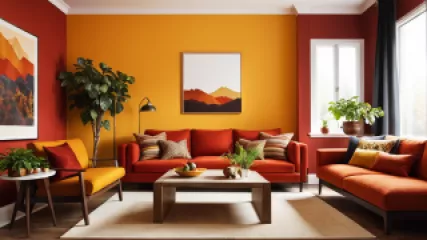Exploring the Psychological Impact of Color in Interior Spaces
Exploring the Psychological Impact of Color in Interior Spaces
Color is an integral part of our daily lives, shaping our perceptions, emotions, and even our overall well-being. In the realm of interior design, the strategic use of color can have a profound impact on the psychological experience of a space. This research summary delves into the intricate relationship between color and its influence on our mental, emotional, and physiological responses within the built environment.
The Science of Color Psychology
Color psychology is a field that examines how the various hues and shades we perceive can affect our thoughts, feelings, and behaviors. Research in this area has revealed that color can have a significant impact on our mood, productivity, and overall sense of well-being. The way we respond to color is deeply rooted in our evolutionary history, as the human brain has developed the ability to associate certain colors with specific environmental cues and emotional responses.
For example, the color red is often associated with increased arousal and excitement, as it triggers the release of adrenaline and stimulates the sympathetic nervous system. Blue, on the other hand, is typically linked to feelings of calmness and serenity, as it has a soothing effect on the mind and body. Green is often perceived as refreshing and restorative, evoking a sense of balance and harmony.
These color-based responses are not just subjective; they have been documented through extensive scientific research. Studies have shown that exposure to certain colors can influence physiological processes, such as heart rate, blood pressure, and even brain activity. Furthermore, the psychological impact of color can vary based on cultural and individual differences, as well as the specific context in which the color is encountered.
The Psychological Impact of Color in Interior Spaces
When it comes to interior design, the strategic use of color can have a profound impact on the psychological experience of a space. By carefully selecting and implementing various color schemes, designers can create environments that elicit desired emotional responses and support the overall well-being of the occupants.
Mood and Emotion
One of the primary ways in which color influences the psychological experience of an interior space is through its impact on mood and emotion. Warm colors, such as red, orange, and yellow, are often associated with feelings of energy, excitement, and even aggression. These colors can stimulate the senses and create a sense of vibrancy, making them well-suited for spaces where productivity and creative expression are desired, such as home offices or art studios.
On the other hand, cool colors, such as blue, green, and purple, are often associated with feelings of calmness, relaxation, and introspection. These colors can have a soothing effect on the mind and body, making them ideal for spaces where relaxation and rejuvenation are the primary goals, such as bedrooms or spa-like bathrooms.
By strategically incorporating these color associations into the design of interior spaces, designers can create environments that support the desired emotional state of the occupants. For example, a cozy living room with warm, earthy tones might foster a sense of comfort and togetherness, while a serene bedroom with cool, calming hues might promote better sleep and relaxation.
Productivity and Focus
In addition to mood and emotion, color can also influence an individual's level of productivity and focus within an interior space. Research has shown that certain colors can have a significant impact on cognitive function, attention, and task performance.
For instance, studies have found that the color blue can enhance creativity and problem-solving abilities, as it has a calming effect on the mind and helps to reduce distractions. This makes blue an ideal color choice for home offices, study areas, or creative workspaces where focused attention and innovative thinking are paramount.
Conversely, the color red has been shown to enhance attention to detail and improve performance on tasks that require accuracy and precision. This makes red a suitable color for areas where meticulous work is required, such as in a dedicated home office or a specialized crafting studio.
By understanding the psychological effects of different colors, interior designers can strategically incorporate them into the design of a space to support the specific needs and goals of the occupants. This can lead to increased productivity, improved focus, and enhanced overall well-being.
Physiological and Behavioral Responses
Beyond the emotional and cognitive impacts, color can also influence our physiological and behavioral responses within an interior space. Research has shown that exposure to certain colors can affect factors such as heart rate, blood pressure, and even hormone levels.
For example, the color red has been linked to increased heart rate and blood pressure, while the color blue has been associated with a calming effect on the cardiovascular system. These physiological responses can, in turn, influence our overall mood, energy levels, and even our propensity for certain behaviors.
Similarly, studies have found that the color green can have a restorative effect on the mind and body, reducing stress and promoting feelings of relaxation and rejuvenation. This makes green an ideal color choice for spaces where stress management and mental well-being are a priority, such as in a yoga studio or a meditation room.
By understanding these physiological and behavioral responses to color, interior designers can create spaces that support the overall health and well-being of the occupants. This can lead to improved sleep quality, reduced stress levels, and even enhanced physical and mental performance.
Practical Applications of Color Psychology in Interior Design
Armed with the knowledge of color psychology, interior designers can strategically incorporate color into their design solutions to create spaces that truly enhance the psychological well-being of the occupants. Here are some practical applications of color psychology in interior design:
Color Schemes and Palettes
When designing an interior space, the selection of color schemes and palettes is crucial. By understanding the psychological effects of different colors, designers can create color schemes that support the specific needs and goals of the occupants. For example, a soothing, monochromatic blue palette might be ideal for a bedroom, while a vibrant, energetic color scheme featuring warm hues might be more suitable for a home gym or a creative workspace.
Zoning and Spatial Organization
The strategic placement of color within an interior space can also have a significant impact on the psychological experience of the occupants. By using color to delineate different zones or areas within a space, designers can create a sense of flow, hierarchy, and purpose. For instance, cool colors might be used to designate areas for relaxation and rest, while warm colors might be used to highlight areas for focused work or social interaction.
Lighting and Color Interaction
The way color interacts with lighting within an interior space can also have a profound impact on the psychological experience of the occupants. Different lighting conditions can enhance or diminish the perceived qualities of a color, affecting the overall mood and atmosphere of a space. By carefully considering the interplay between color and lighting, designers can create environments that are visually striking and psychologically engaging.
Personalization and Customization
In addition to the broader design strategies, the strategic use of color can also be applied on a more personal level. By involving the occupants in the color selection process and incorporating their preferences and associations, designers can create spaces that are truly tailored to the individual's psychological needs and preferences. This can lead to a greater sense of comfort, belonging, and overall well-being within the interior space.
Conclusion
The psychological impact of color in interior spaces is a complex and multifaceted topic that deserves careful consideration. By understanding the science of color psychology and its practical applications in interior design, designers can create spaces that not only look visually appealing but also support the mental, emotional, and physiological well-being of the occupants.
As our understanding of the relationship between color and human psychology continues to evolve, the potential for color to enhance the overall quality of life within the built environment becomes increasingly apparent. By embracing the power of color and its psychological influence, interior designers can transform spaces into havens of well-being, productivity, and personal expression.
Key Takeaways:
- Color psychology examines how different hues can affect our thoughts, feelings, and behaviors, with warm colors often associated with energy and excitement, and cool colors with calmness and relaxation.
- The strategic use of color in interior design can influence mood, productivity, and physiological responses, enabling designers to create spaces that support the overall well-being of the occupants.
- Practical applications of color psychology in interior design include the selection of color schemes and palettes, the use of color to delineate zones and spatial organization, and the integration of color with lighting.
- Personalization and customization of color choices can further enhance the psychological impact of an interior space, tailoring it to the individual needs and preferences of the occupants.
As the field of color psychology continues to evolve, interior designers have an unprecedented opportunity to leverage this knowledge to create spaces that not only look visually appealing but also support the overall well-being of the occupants. By embracing the power of color and its psychological influence, designers can transform the built environment into a haven of well-being, productivity, and personal expression.






